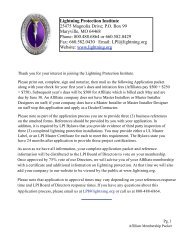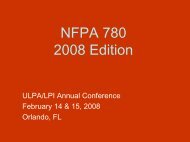contract language to protect the contractor or - Lightning Protection ...
contract language to protect the contractor or - Lightning Protection ...
contract language to protect the contractor or - Lightning Protection ...
You also want an ePaper? Increase the reach of your titles
YUMPU automatically turns print PDFs into web optimized ePapers that Google loves.
CONTRACT LANGUAGETO PROTECT THECONTRACTOROR“MAKING A PROFIT DESPITETHE ODDS”PRESENTED TO: LIGHTING PROTECTION INSTITUTE andUNITED LIGHTING PROTECTION ASSOC.Michael P. Davis, Esq.Chamberlain Hrdlicka WhiteWilliams & Martin191 Peachtree Street – 34th Flo<strong>or</strong>Atlanta, Ge<strong>or</strong>gia 30303
PRACTICAL TIPS FOR SUCCESS1. CONDITION YOUR BIDS- What does that mean in legal terms?- BID=OFFER (GC CAN ACCEPT OFFER)- CONTRACT=OFFER + ACCEPTANCE• You typically bid per plans and specs.• Specs. Inc<strong>or</strong>p<strong>or</strong>ate GC’s boilerplate f<strong>or</strong>mGC ACCEPTS YOUR BID=CONTRACT“BAD THINGS HAPPEN TO GOOD PEOPLE”
Scenario #1:- You begin w<strong>or</strong>k without signing your <strong>contract</strong>- By second pay application you are owed significant sum ofmoney- Ask <strong>to</strong> be paid and GC refuses, must have signed <strong>contract</strong>- No pay, must file lawsuit based on quantum meruit(reasonable value)
Scenario #2:- You propose changes <strong>to</strong> Sub<strong>contract</strong>- GC refuses, insists you sign his boilerplate- Threat <strong>to</strong> “terminate” you and hirereplacement- Hires new sub at higher price, sues f<strong>or</strong>difference, i.e., “promiss<strong>or</strong>y es<strong>to</strong>ppel”
THE CURE:CONDITION YOUR BIDSExample:EFFECT:“This bid is expressly conditioned upon use of <strong>the</strong>Consensus DOCS 750 sub<strong>contract</strong> <strong>or</strong> o<strong>the</strong>r mutuallyagreeable terms and conditions.”(a)(b)(c)Creates defenses <strong>to</strong> <strong>contract</strong> f<strong>or</strong>mationNo “detrimental reliance” <strong>or</strong> “promiss<strong>or</strong>yes<strong>to</strong>ppel”Puts you in position <strong>to</strong> bargain over terms
LETTERS OF INTENTCareful of exculpa<strong>to</strong>ry <strong>language</strong> relieving GC of liability in eventdoes not result in <strong>contract</strong>Do not commit <strong>to</strong> <strong>contract</strong> <strong>language</strong>, schedules, etc.Be sure <strong>to</strong> include <strong>language</strong> f<strong>or</strong> paymentExample:“However, in <strong>the</strong> event GC does not enter in<strong>to</strong> <strong>contract</strong>with Sub f<strong>or</strong> any reason, GC shall pay Sub f<strong>or</strong> all w<strong>or</strong>kin place and s<strong>to</strong>red materials, no later than fifteen daysfrom invoice.”
READ THE CONTRACT “BEFORE” SIGNINGWHY?!?- Because:- Every Contract Term is a Job Cost- Cost assumptions should be <strong>contract</strong> termsExample:You intend <strong>to</strong> do w<strong>or</strong>k in logicalsequence with reasonable manpowerincrease over specific duration, e.g., multiple phaseswith gradual manpower increase f<strong>or</strong> two months;What if time cut in half and sequencechanged? = Inefficient lab<strong>or</strong> andincreased costs
Know Contract Requirements <strong>to</strong> Make Reasoned DecisionWhe<strong>the</strong>r To Accept Based on Risk/Benefit Analysis• Difficult job• Bad drawings• Tough Owner/GC• Tight site foot print• Bad wea<strong>the</strong>r (winter)• Low profit margin• O<strong>the</strong>r w<strong>or</strong>k available in market placeSOMETIMES THE BEST DECISION IS TO NOT TAKE THEJOB.
OTHER PURPOSES OF CONTRACT REVIEW AND NEGOTIATIONS:- Send a “message” <strong>to</strong> GC- Want <strong>to</strong> be an equal partner; not “weak sister” sub- May be able <strong>to</strong> get some “concessions,” such as lower retainage <strong>or</strong>elimination of “pay-if-paid” clauses
“NOTICE” REQUIREMENTS- May have sh<strong>or</strong>t time <strong>to</strong> notify GC of claim f<strong>or</strong> extra w<strong>or</strong>k, e.g.“no later than 5 days from events giving rise <strong>to</strong> claim.”- O<strong>the</strong>rwise claim may be waived
KNOW OPTIONS IN CASE OF DISPUTE- Some sub<strong>contract</strong>s say must file f<strong>or</strong> arbitration within 30days of “final decision” <strong>or</strong> “waive” rights, i.e., lose <strong>the</strong>m- Arbitration at “sole option” of GC- Avoid court/hearing locations in distant venue, i.e.,Minnesota when project in Alabama- Avoid “home cooking”, i.e., agree <strong>to</strong> venue in local courtnearest GC’s offices- Avoid agreement governed by laws of ano<strong>the</strong>r state (seeabove example)
AVOID “PAY-IF-PAID” CLAUSESExample:“GC shall pay Sub within 10 days afterreceipt of payment from Owner. Subexpressly acknowledges that GC shallhave no obligation <strong>to</strong> pay Sub in <strong>the</strong> even<strong>to</strong>f non-payment by Owner.” Sub isrelying strictly on <strong>the</strong> credit w<strong>or</strong>thinessand payment by Owner.”
WHY – ENFORCEABLE IN MANY STATES!Legally, GC not required <strong>to</strong> pay- WORSE NEWS: surety can usually raise as defense
Alternative <strong>language</strong>: “However, in <strong>the</strong> event GC is not paidthrough no fault of Sub, <strong>the</strong>n GC shall pay Sub within areasonable time period.” (<strong>or</strong>, “pursuant <strong>to</strong> <strong>the</strong> payment termsherein”).
RETAINAGEProfit on <strong>the</strong> job!Retainage should be kept as low as possibleExample:- No greater than Owner holds on GC“Retainage shall be reduced in equalprop<strong>or</strong>tion <strong>to</strong> percent of retainage held by Owner onGeneral Contrac<strong>to</strong>r.”
Include <strong>language</strong> as bid condition <strong>or</strong> in sub<strong>contract</strong>Government <strong>contract</strong>s generally reduced <strong>to</strong> 5% at halfway poin<strong>to</strong>f project if satisfac<strong>to</strong>ry progress.Example:“Provided that Sub’s perf<strong>or</strong>mance issatisfac<strong>to</strong>ry at <strong>the</strong> point it completes 50% of itsw<strong>or</strong>k, GC shall cease any fur<strong>the</strong>r deductions ofretainage.”
Negotiate 5% retainage, reduced <strong>to</strong> 2 ½% at SubstantialCompletion (“beneficial use and occupancy”).Retainage should be fully released when Owner accepts yourw<strong>or</strong>k. (NOT THE ENTIRE PROJECT).
JOB SITE CONDITIONSNot ready f<strong>or</strong> delivery installation per <strong>contract</strong> scheduleExample:- Methods <strong>to</strong> address:Add <strong>language</strong> <strong>to</strong> bid proposal <strong>or</strong> sub<strong>contract</strong>“Any delays in delivery <strong>or</strong> installation shall result in a change<strong>or</strong>der f<strong>or</strong> increased costs, <strong>to</strong> be submitted per sub<strong>contract</strong>provisions.Alternative – “In <strong>the</strong> event <strong>the</strong> project site is not ready f<strong>or</strong> delivery<strong>or</strong> installation per <strong>the</strong> <strong>contract</strong> schedule, Sub shall be paid f<strong>or</strong>s<strong>to</strong>red materials, plus <strong>the</strong> cost of s<strong>to</strong>rage, where applicable.”
SCHEDULING, SEQUENCING AND DURATIONThree keys <strong>to</strong> managing w<strong>or</strong>k profitably.Key components in <strong>the</strong> logic used in bidTo be successful, must have input in<strong>to</strong> schedule, sequence andduration.Avoid, <strong>contract</strong> <strong>language</strong> giving GC sole right <strong>to</strong> changeschedule, sequence <strong>or</strong> duration, absent right <strong>to</strong> additionalcompensation.
Example:“GC shall have <strong>the</strong> unilateral right <strong>to</strong> amend <strong>or</strong> change<strong>the</strong> schedule, duration, <strong>or</strong> sequence of w<strong>or</strong>k, all withoutany additional compensation.”Change <strong>to</strong>:In <strong>the</strong> event <strong>the</strong> schedule, sequence <strong>or</strong> duration ofactivities is altered from <strong>the</strong> <strong>or</strong>iginal schedule, Sub shallbe compensated per <strong>the</strong> change <strong>or</strong>der process outlinedherein.”
ACCESS TO WORK AREAInability <strong>to</strong> readily access w<strong>or</strong>k site costs money- Site may have one access road, muddy conditionsLack of access <strong>to</strong> eleva<strong>to</strong>rs (hoists <strong>to</strong> move men and materialsis costly)- May have <strong>to</strong> walk materials in<strong>to</strong> w<strong>or</strong>k area
Suggested Addition <strong>to</strong> Sub<strong>contract</strong>:“Sub assumes GC <strong>to</strong> provide adequate access <strong>to</strong> <strong>the</strong>w<strong>or</strong>k site so as <strong>to</strong> not impair <strong>or</strong> impede Sub’s ability <strong>to</strong>expeditiously perf<strong>or</strong>m its w<strong>or</strong>k.”
BACKCHARGESMust have adequate notice of potential backcharge, i.e., “GCshall give Sub seven (7) days writtennotice pri<strong>or</strong> <strong>to</strong> assessing backcharges.”Be clear regarding clean up duties- Sub responsible <strong>to</strong> clean own w<strong>or</strong>k area, not part ofcomposite crew.
Example:“Sub shall be responsible <strong>to</strong> clean up its own w<strong>or</strong>k area at<strong>the</strong> end of each day. Failure <strong>to</strong> do so shall result in notice ofdefault and an opp<strong>or</strong>tunity <strong>to</strong> cure within three w<strong>or</strong>king daysof notice.”
UNHOLY TRINITYINDEMNIFICATION, WAIVER OFSUBROGATION AND ADDITIONALINSURED- Indemnification clause may guaranteeSub <strong>or</strong> insurance carrier pays f<strong>or</strong> thirdparty’s own err<strong>or</strong>s/negligenceAvoid Broad F<strong>or</strong>m Hold Harmless Language- May be unenf<strong>or</strong>ceable per state law
Example:“Sub shall defend and indemnify GC, Owner,Architect and <strong>the</strong>ir representatives f<strong>or</strong> anydamages <strong>or</strong> injury <strong>to</strong> persons <strong>or</strong> propertyarising out of <strong>the</strong> W<strong>or</strong>k, except f<strong>or</strong> <strong>the</strong> solenegligence of any indemnitee hereunder.”
The Fix:Strike <strong>the</strong> w<strong>or</strong>d “sole,” <strong>or</strong> add “but only <strong>to</strong> <strong>the</strong> extent caused by<strong>the</strong> negligent acts <strong>or</strong> omissions of <strong>the</strong> Sub.”
Additional Insured- Requires Sub list GC and Owner under its policy- Effect: GC makes claim f<strong>or</strong> coverage under your policy,not <strong>the</strong>irs.Recommendation:Talk with your broker and make sure c<strong>or</strong>rectcoverage in place per ISO f<strong>or</strong>m documents.Also, avoid listing architect <strong>or</strong> unknown “representativesas additional insureds.
Waiver of Subrogation- Requires your carrier give up its rights <strong>to</strong> recover fromGC’s carrier f<strong>or</strong> GC’s negligent acts.The Remedy:Eliminate broad f<strong>or</strong>m indemnity and may noteffect subrogation rights.
Conclusion/Summary- Condition Your bid- Read sub<strong>contract</strong>, revise and negotiate- Analyze if good project <strong>to</strong> assume risk- Give timely notice (claims, change <strong>or</strong>ders, etc.)- Deal with GC from strengthTrade <strong>contract</strong><strong>or</strong>s build projects, not GC’s.Improve <strong>the</strong> odds <strong>to</strong> get paid f<strong>or</strong> your w<strong>or</strong>k.













